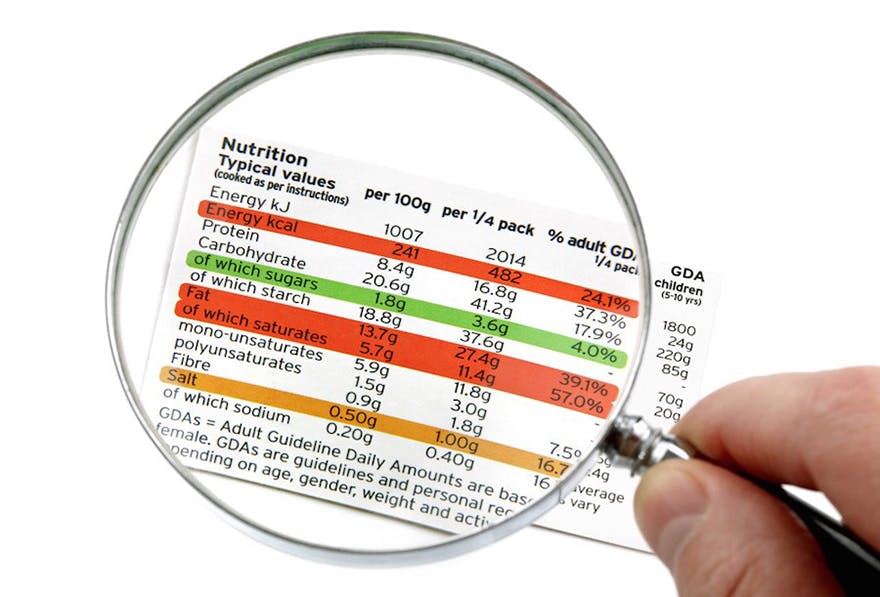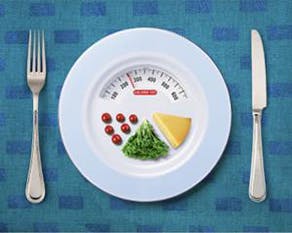Translating Food Labels for Healthy Food Decisions
FOOD & NUTRITION
05.30.2014

Does nutrition label lingo seem as foreign as another language? Use this ingredients guide to help read and interpret food labels so you can make healthy food decisions more readily.
1. Size matters. Start with serving size and number of servings per package container. Serving sizes are standardized to make it easier to compare similar foods. They’re provided in familiar units such as cups or pieces, followed by the metric amount.
The serving size affects the number of calories and all of the nutrient amounts listed on the top section of the Nutrition Facts portion of the label.
NOTE: Pay attention to the number of servings in the entire package, and determine how many servings you actually consume (1/2 serving, 1 or more). Many processed foods purchased in single-serving packages, actually contain two or more servings. According to the Nutrition Labeling and Education Act (NLEA) of 1990, a food item in a small container may be labeled as a single serving if the entire contents can reasonably be consumed at one time.
Sneaky snacks: Products like potato chips can be tricky because serving size varies depending on packaging. A snack-size single serving bag has fewer calories than a larger bag, but the larger size can still be considered a “single serving.”
Other items to watch out for include over-sized muffins and bagels, which are really two servings…"individual" ice cream containers (some contain 4 servings)…and “personal size” pizzas.
2. Got energy? The number of calories you consume determines the energy you get from a serving of food. Many Americans’ caloric intake is greater than they need yet doesn’t meet recommended nutrient amounts. Pay attention to the calorie section of the food label: it can help you gain, lose, or maintain weight. Remember, the number of servings you consume determines the number of calories you consume.
3. Nutrient No-Nos. The nutrients listed first are the ones Americans generally consume too much of. Consuming too many calories, saturated fat, trans fat, cholesterol, or sodium may increase your risk of heart disease and high blood pressure. Health experts recommend that you keep your intake of saturated fat, trans fat and cholesterol as low as possible to help maintain a nutritionally-balanced diet.
4. Filler Uppers. Most Americans don't get enough dietary fiber, Vitamin A, Vitamin C, Calcium, and Iron in their diets. Eating enough of these nutrients can promote and maintain good health. A diet high in soluble fiber and low in saturated fat and cholesterol promotes healthy intestines and may reduce the risk of heart disease.
5. Daily Values (DV). The % DV helps you link nutrients in a serving of food to their contribution to your total daily diet. It also helps you determine if a serving of food is high or low in nutrients, and to compare nutritional values of foods. In Nutrition % DVs are based on a 2,000 calorie diet.
The Daily Values for each listed nutrient are based on public health experts recommendations. The % Daily Values are based on the Daily Value recommendations for key nutrients for a 2,000 calorie daily diet. Even if you don’t know how many daily calories you consume, you can still use the % DV as a reference point whether or not you consume more or less than 2,000 calories.
Don’t worry about being a math whiz to calculate % values: the label does it for you. It helps you interpret the numbers (grams and milligrams) by putting them all on the same daily scale (0-100 % DV). The % DV column doesn't add up to 100%. Each nutrient is based on 100% of the daily requirements for that nutrient (according to a 2,000 calorie diet). This way you can tell high amounts from low and know which nutrients contribute a lot, or a little, to your recommended daily allowance.
For all nutrients, a daily value of 5% or less is considered low. Look for this when you want to limit nutrients such as fat, saturated fat, cholesterol, and sodium; for those you want to consume in greater amounts, such as fiber and calcium, look for daily values of 20%, which is considered a high value for all nutrients.
Image Credits: Brian A Jackson/Shutterstock.com
Recommended Articles
The 5 Best Foods That Will Help Supercharge Your Brain
Amidst our busy schedule, it's important to retain our focus and memory. Resting alone is not...
Iron deficiency is a lot more common than you would think. A recent survey by SATA CommHealth(i...
Mars vs Venus: Understanding the His and Hers of Nutritional Needs
Mars vs Venus: Understanding the His and Hers of Nutritional Gaps Although their DNAs are...






